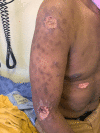Disseminated sporotrichosis in a person with human immunodeficiency virus disease
- PMID: 34712907
- PMCID: PMC8549385
- DOI: 10.1099/acmi.0.000262
Disseminated sporotrichosis in a person with human immunodeficiency virus disease
Abstract
Introduction: Disseminated sporotrichosis is an incapacitating infection caused by the dimorphic fungus Sporothrix schenckii. Because this condition may mimic the presentation of tuberculosis, syphilis and other bacterial infections, the diagnosis may be missed or delayed.
Case presentation: We describe a case of disseminated sporotrichosis in a patient with poorly controlled human immunodeficiency virus infection. The patient was initially treated for bacterial skin infections. The differential diagnosis also included tuberculosis and syphilis. Only after appropriate specimens had been sent for microbiological and histopathological investigations was the diagnosis of disseminated sporotrichosis made and appropriate treatment started. The patient showed a good clinical response to itraconazole.
Conclusion: This report highlights the importance of having a high index of suspicion of endemic mycoses when managing immunocompromised patients. The report also demonstrates that a delay in the diagnosis of sporotrichosis increases morbidity and results in unnecessary and inappropriate treatment with associated costs and adverse effects.
Keywords: Sporothrix schenkii; disseminated sporotrichosis; human immunodeficiency virus; sporotrichosis.
© 2021 The Authors.
Conflict of interest statement
The authors declare that there are no conflicts of interest.
Figures





References
-
- Schenck B. On refractory subcutaneous abscesses caused by a fungus possibly related to sporotrichia. John Hopkins Hosp. 1898;9:286–290.
Publication types
LinkOut - more resources
Full Text Sources
